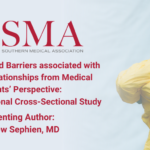Abstract | November 13, 2020
Facilitators and Barriers associated with Mentoring Relationships from Medical Students’ Perspective – A Multi-Institutional Cross-Sectional Study
Learning Objectives
- Know the incidence of mentoring among medical students across the United States.
- Know the most commonly reported quality of a successful mentor from a medical student's perspective.
- Know the most commonly reported barrier in preventing a successful relationship.
Background/Knowledge Gap: Mentoring is important for both professional and personal development in medical education. However, the characteristics of mentoring relationships among medical students are not well characterized. Despite its importance, the prevalence medical student mentorship ranges dramatically between 26%-77%, with studies primarily focusing on a specific population of medical students. The primary goal of this study was to update and determine the rate of mentorship among medical students across medical schools in the United States. The secondary goals were to assess the facilitators and barriers associated with finding a mentor and the desired qualities of a successful mentor from the perspective of medical students across all four years of medical school.
Methods/Design: A cross-sectional online survey was administered via Qualtrics to all undergraduate medical students at participating accredited medical schools from July 2018 to March 2019. The 42-question survey contained a sub-section of 11 questions which assessed the presence of mentoring among each responder, the setting of how the mentor was obtained, and facilitators and barriers in finding a mentor, and the desired qualities in a successful mentor. Item formats included yes/no questions, a 5-point Likert scale, “choose up to 3” qualities, and demographic information. Post hoc analysis revealed a sample size of 532 students provides 95% confidence with a margin of error of ±4 which makes the sample adequately representative.
Results/Findings: Nineteen (32%) of 59 responding medical schools (17 public and 2 privately funded) responded and participated in the study. With a 94% completion rate, 369 (69%, n=532) of medical students reported having a mentor. Fourth-year medical students were significantly more likely to have a mentor compared with first-year (OR 1.98; 95% CI 1.14, 3.46; p=0.016), second-year (OR 1.9; 95% CI 1.06, 3.39; p=0.03) or third-year students (OR 2.58; 95% CI 1.45, 4.60; p=0.001). Compassion (64%) and lack of time from mentor (75%) were the most commonly reported quality and barrier of a successful mentoring relationship, respectively.
Conclusions/Implications: Medical students desire mentors to guide them through their medical education. This study defines the desired qualities of mentors and may serve as a guide to fostering more supportive mentoring relationships. However, each mentoring relationship should be tailored to the needs of the mentee.

